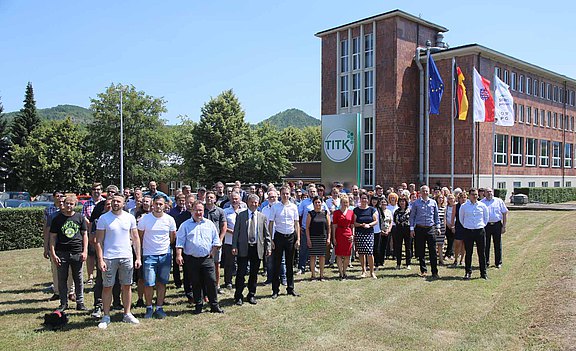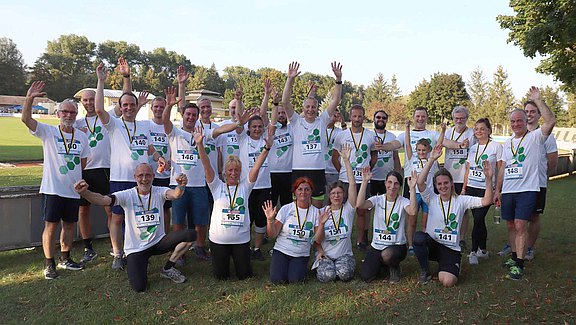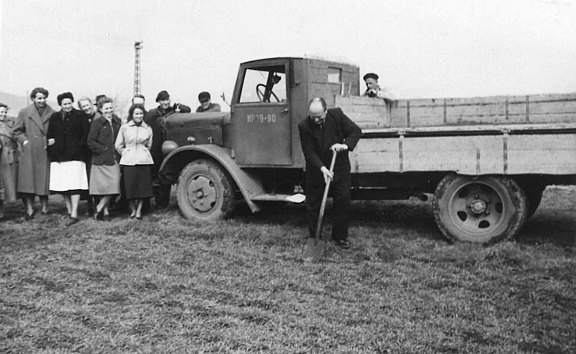When the collective combine was wound up on July 1, 1990 – the day of the Economic and Monetary Union – the trust did not provide a concept for industrial research. It decreed: closure of that business unit at the end of 1992. The former head of institute, Dr. Horst Bürger, and his most important experts, however, would not give up that easily. They initiated the first private-law, non-profit research institute in the re-established Free State of Thuringia with a crew of 55 scientists, laboratory technicians, and skilled workers at their back. And they had a clear vision of a new strategic profile: The rather tight focus on chemical fibers and their processing in the classical areas of spinning, weaving, warp knitting/knitting, and manufacture has to be extended urgently. The aim: to investigate all options of “new organic structural and functional materials” on the basis of a “scientifically and economically convincing concept”.
On October 4, 1991, 23 founding members – among them enterprises and institutions from West Germany, and even the USA and Japan – launched the association “Thüringisches Institut für Textil- und Kunststoff-Forschung Rudolstadt e.V.” (TITK or “Thuringian Institute for Textile and Plastics Research”). A working principle proclaimed already then still apples for today: Market needs are to be the central theme, economic relevance has to be sound out for every new development at an early stage. It is this principle, the director of the institute, Benjamin Redlingshöfer, who followed in the footsteps of TITK founding father Dr. Horst Bürger and his successor Dr. Ralf-Uwe Bauer, swears by. “When we develop polymer materials for innumerable fields of application, it is not as an end in itself. We provide innovations which create a competitive edge for our customers”, Redlingshöfer says. He considers as perhaps most important inheritance from the former reorientation that as research institute close to business – particularly as not base-funded - they can only be successful in the long term “if our new developments supply economic added value.”
Having had the claim from the start “to convince through creativity, initiative, and performance” TITK has long since developed from a mere material research institute to a provider of systems and solutions for future technologies. Year after year 140 scientists, technicians, and laboratory assistants engage in up to 70 projects in the fields of native polymers and chemical research, textile and materials research, plastic research as well as functional polymer systems and physical research. Renowned companies from all over the world trust in their expertise, such as car manufacturer BMW whose electric car components from carbon, natural, and recycled fibers were created by the help of TITK. Or the Finnish Metsä group which acquired professional know-how from Rudolstadt for their wood-based textile fibers. Not to forget the US-American enterprise Bolt Threads which invented a protein-based material in cooperation with TITK to be used in an entirely bio-degradable tennis dress of Adidas and designer Stella McCartney.
Research achievements from TITK have been repeatedly award-winning. Recent examples are the flexible, metal-free heating foil with integrated overheat protection and the bio-based and biodegradable hot melt for packaging solutions. A technology allowing temperature regulating clothing already obtained the Thuringian research award some years ago. The basis for that technology was the ALCERU procedure developed at TITK in to equip Lyocell fibers with additional functions. Meanwhile, there exists an internationally acclaimed further development: Lyohemp, the first Lyocell fiber where the cellulose is made from hemp and not wood. Therefore, TITK stays deeply rooted in the over 80-year-old tradition of cellulose research on the rivers of Saale and Schwarza, and, at the same time, strengthens the principle of recycling economy and conservation of resources which is becoming increasingly important.
30 years of TITK are a success story, without doubt, which is worthwhile to be told. This should take place at a festive event, of course. Corona, however, put a spoke in the wheel. The institute management takes it easy and intends to celebrate the 33 years accordingly. An idea with charm as in 2024 the first groundbreaking of Hans Böhringer would also date of 70 years since then.
This article first published in Wirtschaftsspiegel Thüringen.


